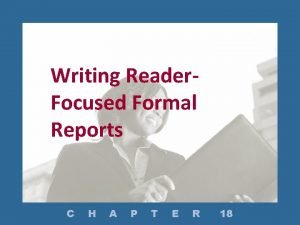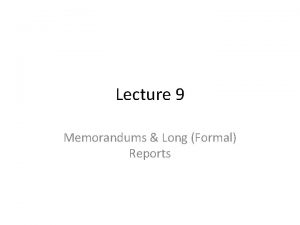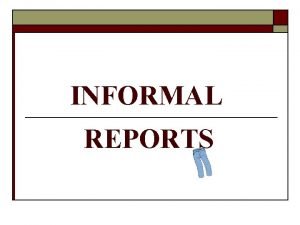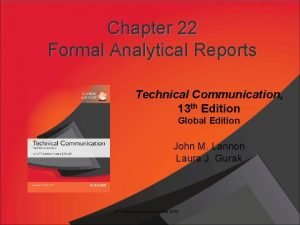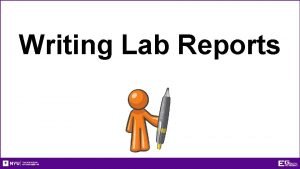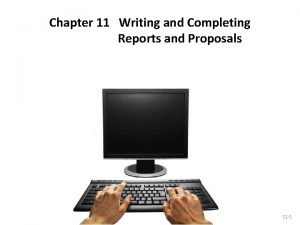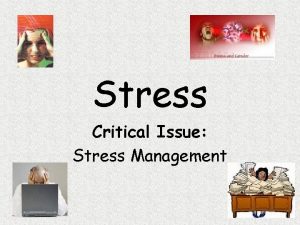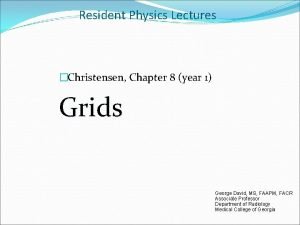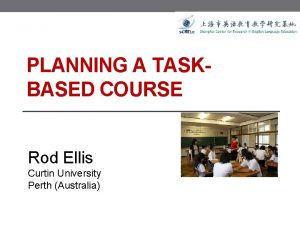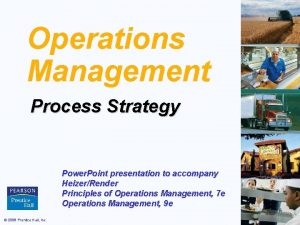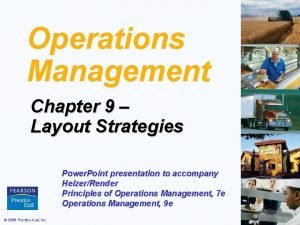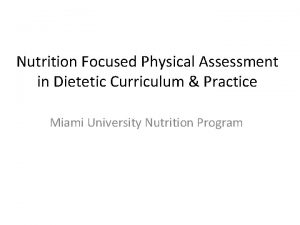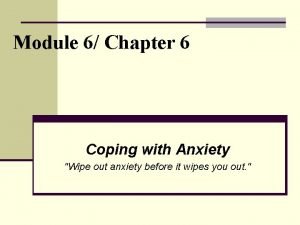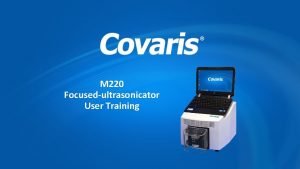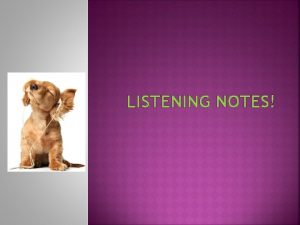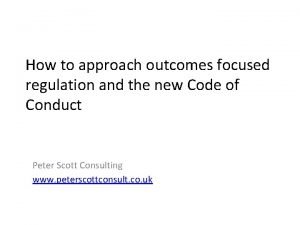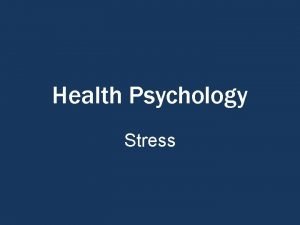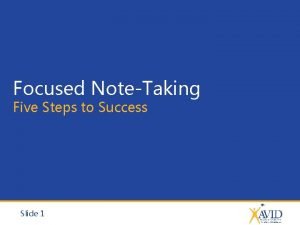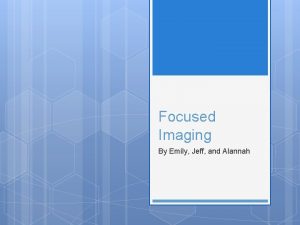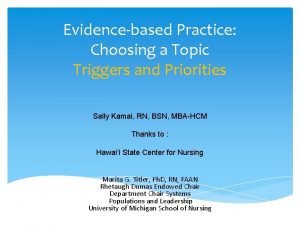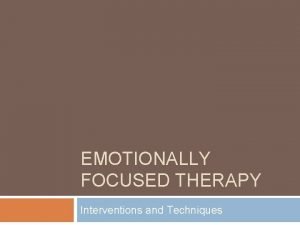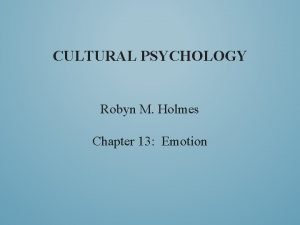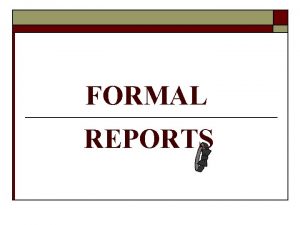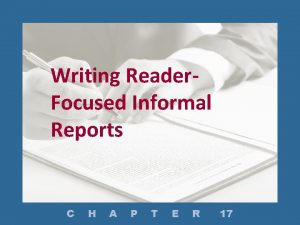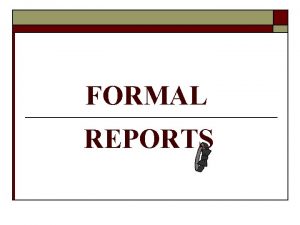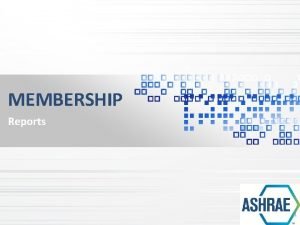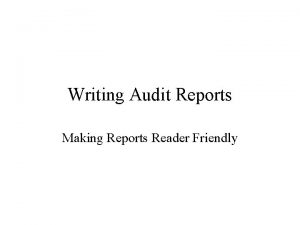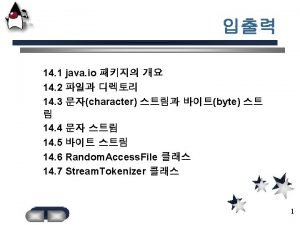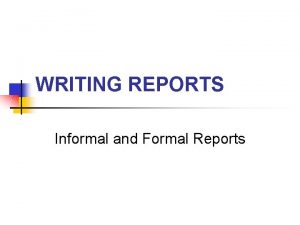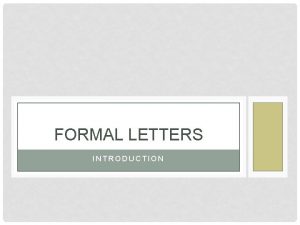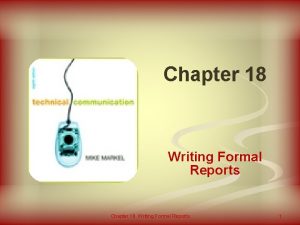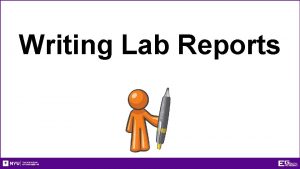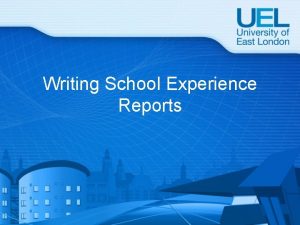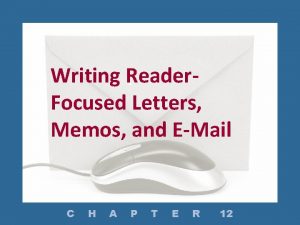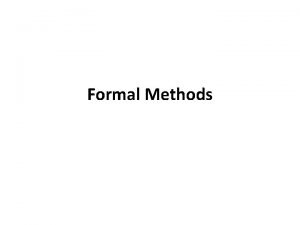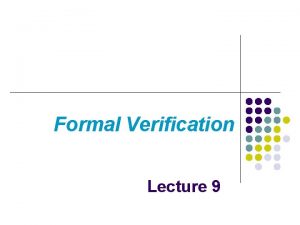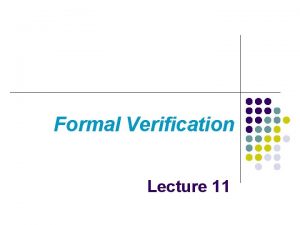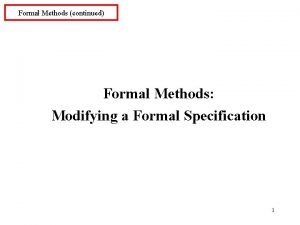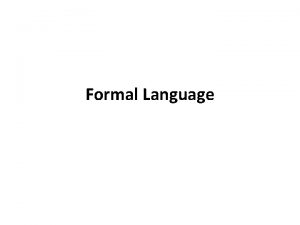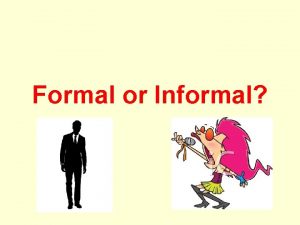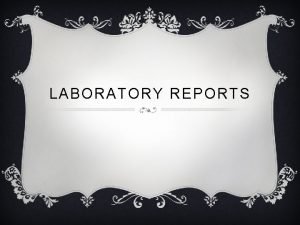Writing Reader Focused Formal Reports C H A





























- Slides: 29

Writing Reader. Focused Formal Reports C H A P T E R 18

Presentation Overview • How Does a Formal Report Differ from an Informal Report? • What Are the Types of Reports? • How Do You Prepare to Write a Formal Report? • How Do You Structure the Body of a Formal Report? • What Are the Elements of Front and Back Matter? • How Do You Write a Feasibility Report?

How Does a Formal Report Differ from an Informal Report? Informal Report Formal Report • Written to communicate information about routine, everyday business • Written to communicate less-routine business • Formatted using a memo, letter, e-mail, forms or templates, or a formal report format • Formatted in most cases using a formal report format, which contains front and back matter

What Are the Types of Reports? • Information reports • Analytical reports • Recommendation reports

Information Reports • Present information on the status of current research or of a project. • Explain how your organization or division does something. • Present the results of a questionnaire or research.

Analytical Reports • Explain what caused a problem or situation. • Explain the potential results of a particular course of action. • Suggest which option, action, or procedure is best.

Recommendation Reports • Recommend a course of action for dealing with a problem. • Look at whether your organization can or should do something. • Examine whether a change would benefit your organization.

How Do You Prepare to Write a Formal Report? 1. 2. 3. 4. 5. Determine your purpose. Identify the readers. Formulate specific questions. Conduct research to find the answers. Make conclusions and recommendations based on sound research.

Determine Your Purpose Ask: • What do you want readers to know, do, or learn from the report? • Do you only want to present results? • Do you want to draw conclusions? • Do you want to make recommendations based on those conclusions? • Is the report routine?

Identify the Readers • Their knowledge about your field or the topic of your report • Their reason for reading the report • The level of detail they need or expect, and the different needs or expectations among readers • The level of formality they expect

Identify the Readers • Their position inside or outside your organization, and if inside, their position within the organizational hierarchy • The various groups reading the report • Their knowledge and opinions of you and your organization

Formulate Specific Questions • Determine what information you need to know to write the report, based on your purpose for writing and your readers’ needs and expectations. • Refine your research question by adding specific details to it.

Formulate Specific Questions Vague Which facility should we purchase? Specific Of all the facilities available for purchase, which one would offer • the greatest visibility • the most convenient location for our customers • the most secure neighborhood • the lowest cost (purchase, taxes, remodeling) • the most square footage • the best layout • the greatest parking availability

Conduct Research to Find the Answers • Determine what primary research techniques and secondary research strategies are appropriate for answering your questions.

Make Conclusions and Recommendations • Ensure that your research is thorough enough to enable you to draw valid conclusions. • Look for cause-and-effect relationships. • Be wary of results that seem to point to the same conclusions. • Let the results of your research dictate your recommendation. • Watch for areas where you have used illogical or unsupported arguments.

How Do You Structure the Body of a Formal Report? Introduction Methods Results Conclusions (analytical and recommendation reports) • Recommendations (recommendation reports) • •

Introduction • Identify the purpose of the report. • Identify the topic of the report. • Indicate how the report affects or relates to readers. • Present background information. • Present an overview of the report.

Introduction Example Workers in the downtown area have many choices when it comes to buying their morning coffee. A good coffee house will offer fresh coffee at reasonable prices, a variety of coffees from which you can choose, and a friendly smile. The staff at Cup of Joe magazine investigated the coffee houses located in a five-mile radius from the courthouse to find the best one. We compared these six coffee houses. . In the end, Java Junction stood out as the clear winner.

Methods • Answer the question, “How did I do the research or conduct the study? ” • Use language specific enough for others to reproduce your research method.

Methods Example To find the best coffee house, we visited each one between 10: 00 -11: 00 am. . We rated the coffee houses using the following criteria: • Price: We ordered a 12 oz. cup of the house blend. We awarded 10 points to the coffee house with the lowest cost, 5 to the coffee house with the next lowest cost, and 0 to all others. • Variety of Coffee: We counted the number of coffees available. We awarded 10 points to the coffee house with the most variety, 5 to the coffee house with the next most variety, and 0 to all others. . We determined the overall rating by adding the points together.

Results • Answer the question, “What did you learn? ” • Include only the results. • Use a standard pattern of organization to organize the results. • Use graphics when appropriate.

Results Karma Café Cost: For the house blend, what was the cost for a 12 oz. cup? $3. 00 Rating: 0 points Variety of Coffee: How many coffees were available? 6 – Second Most Variety Rating: 5 points Freshness: How long was it since the coffee was last brewed? 15 minutes—First Most Fresh Rating: 10 points Quality of Service: • Did the server greet us? • Did the server thank us? • How long did it take him or her to serve the coffee? • How long did it take him or her to give change? 4—Best Service Yes 30 seconds —Fastest Total 25 points 10 seconds —Fastest Rating: 10 points

Conclusions • Answer the question, “What do the results mean? ” • Interpret and explain the significance of the results. • State your conclusions clearly and confidently.

Conclusions Example The ratings reveal that more expensive coffee houses consistently offer more variety, fresher coffee, and better service. .

Recommendations • Answer the question, “Based on the results and the conclusions, what do you recommend? ” • State the recommendations in clear, direct language. • Make sure your recommendations clearly follow the conclusions and results. • Eliminate unnecessary explanations of the recommendations.

Recommendations Example We recommend Java Junction as the best place for coffee. It may not be the absolute cheapest, but it isn’t the most expensive either. However, it does have the freshest coffee and best service and the second best selection. For an all-around good experience, visit Java Junction.

What Are the Elements of Front and Back Matter? Front Matter • • • Letter of transmittal Cover Title page Table of contents List of illustrations Abstract and executive summary Back Matter • • • Works cited or list of references Glossary List of abbreviations or symbols Appendices Index

How Do You Write a Feasibility Report? 1. 2. 3. 4. Establish the criteria. Identify the options. Gather information and evaluate the options. Draw conclusions and make sound recommendations. 5. Organize the results section by criteria or by options.

Questions?
 How do informational reports and analytical reports differ
How do informational reports and analytical reports differ Long formal report
Long formal report Informal report memo format
Informal report memo format Analytical reports are always formal
Analytical reports are always formal Difference between formal and informal proposals
Difference between formal and informal proposals Writing formal informal
Writing formal informal Examples of informal writing style
Examples of informal writing style Similarities of technical writing and academic writing
Similarities of technical writing and academic writing Purpose of writing reports
Purpose of writing reports Writing and completing reports and proposals
Writing and completing reports and proposals Prefatory part of report
Prefatory part of report Apa itu laporan singkat
Apa itu laporan singkat Problem-focused coping examples
Problem-focused coping examples Lateral decentering grid
Lateral decentering grid Focused and unfocused tasks examples
Focused and unfocused tasks examples Operations management process strategy
Operations management process strategy Layout strategy example
Layout strategy example Nutrition assessment
Nutrition assessment Nutrition focused physical assessment
Nutrition focused physical assessment Problem focused coping examples
Problem focused coping examples Afa grade water
Afa grade water Active listening is focused and purposeful
Active listening is focused and purposeful Outcomes focused regulation
Outcomes focused regulation Stress definition psychology
Stress definition psychology Aura phase serial killer
Aura phase serial killer 5 steps of focused note taking
5 steps of focused note taking Focused imaging learning
Focused imaging learning Evidence based practice topics
Evidence based practice topics Eft cycle
Eft cycle Ego-focused emotions relate to:
Ego-focused emotions relate to:
